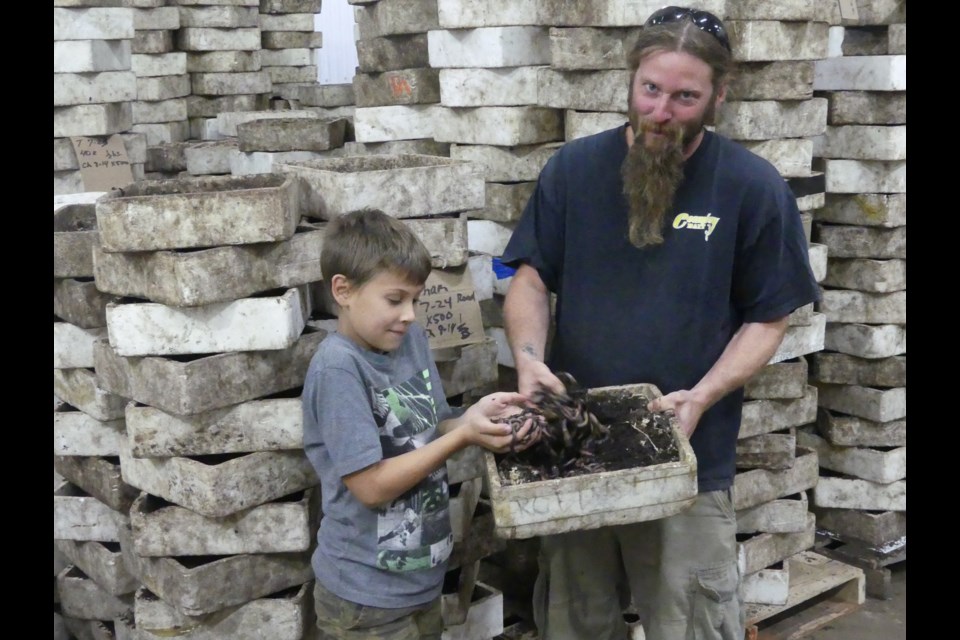Just below the surface of the soil in parts of Southwestern Ontario are hundreds of millions of slippery, slimy, wriggly worms that make up one of the province’s most lucrative agricultural industries: bait worms.
In the middle of the night, while many of us are sleeping, hundreds of worm pickers march through farmers’ fields stretching from Windsor to Toronto, armed with a headlamp and two coffee cans strapped to their ankles: one for the worms, and one filled with sawdust to dry off gooey fingers.
Working quickly and quietly, they pluck as many worms as they can before the sun comes up and the worms retreat back into the earth.
But many people who enjoy recreational fishing might not be aware of the story behind their bait. The global supply of approximately 700 million dew worms, also known as nightcrawlers, is almost entirely sourced from the nutrient-rich soil on local dairy farms, some of which are found right here in Wellington County.
Today, the industry is worth an estimated $230 million, according to a study from the University of Toronto, and it works something like this: Farmland owners will rent a section of their acreage to a team of worm pickers, who are supervised by a crew chief, who sells the worms to cooling businesses for storage before being shipped to bait-and-tackle shops, convenience stores and other wholesalers across Canada, the United States and Europe.
But the unregulated and mostly cash-based industry has historically been a wild west of aggressive turf wars and competitive price bidding, the latter of which has made a resurgence since the start of the COVID-19 pandemic.
According to some industry actors, a combination of factors including increasing labour shortages, extreme weather, and volatile supply and demand has made the turbulent industry even more cutthroat.
“There are no friends in this business,” jokes Ryan Dekker, who manages Country Bait, a family-owned cooling business in Moorefield, roughly 50 kilometres northwest of Guelph.
But he’s faced some serious challenges this season.
“We could tell it was going to be a crisis year anyway, because there was some low production in the fall. And then as soon as the impact of COVID was realized, the price really started to go up.”
At the height of lockdown restrictions in May, Dekker says he was unable to hire enough picking crews through the government’s Temporary Foreign Worker Program and was forced to reduce his typical 30-person workforce to around 10 people.
Extreme temperatures at the start of this year’s season and at the end of last year also decreased worm productivity, which caused the average price to double or triple from the standard rate of $40 per 1000 worms. As a result, Dekker says some cooling businesses and landowners have become even more aggressive in their attempts to poach crew chiefs.
“When all of a sudden there's only 30 or 40 percent of your workforce, you get people bidding on the worms and the price can just skyrocket in no time flat,” he said, noting that the consumer doesn’t typically absorb the cost, which is a just few dollars per dozen at most convenience stores. “The pickers who are free to go wherever they want are going to go where the highest price is. That's the bottom line.”
University of Toronto PhD candidate Joshua Steckley, author of the aforementioned study, is trying to better understand how the industry operates today and how it has evolved over time. According to his research, the industry itself dates back to the post-WWII era, when early worm pickers were mainly European and Korean immigrants.
Then, the Vietnam War of the late 1970s and early 80s prompted an unprecedented number of Vietnamese and other Southeast Asian immigrants and refugees to be accepted into Canada, where some found their first jobs as worm pickers because of the high pay-off and minimal training and language requirements.
It was during this time that: “the land, labour, and infrastructure … made Toronto ‘the worm capital of the world.’”
Still, much remains unknown about the Ontario bait worm industry – and Steckley insists it deserves more attention. His research has helped him uncover details about the environmental and economic implications of dew worm production, the immigrant and non-immigrant labour market, as well as the history and the future of recreational fishing itself.
In addition to publishing multiple papers about the industry, he has produced a short YouTube video and he plans to take his research even further.
“The value of the earthworm is more than Ontario peaches or strawberries, and nobody is taking notice of this,” he said. “I would like to turn this into a book … I'm not sure if it's going to be more academically-minded or more popular in its writing, but we'll see.”



